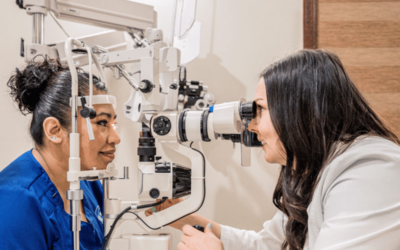Does your child constantly struggle with blurry vision? They may be dealing with myopia, or nearsightedness—a common condition that makes it hard to see distant objects clearly. At Prairie Vista Eye & Optical, we offer myopia management in Liberal to help slow myopia progression and protect your child’s future eyesight.
Myopia is on the rise in children and, if left unmanaged, can lead to serious eye health risks later in life. In this blog, we’ll explain what myopia is, what causes it, the symptoms to watch for, and how early management can make a significant difference.
What is myopia?
Myopia is a refractive error that occurs when the eyeball is too long or the cornea (the front part of the eye) is too curved. This causes light to focus in front of the retina, rather than on the retina, which results in blurry distant vision. While myopia can affect people of all ages, it’s more common among children and adolescents.
What are the symptoms of myopia?
Recognizing the early signs of myopia in your child is essential for getting them the right treatment. Here are some common symptoms of myopia in children:
- Difficulty seeing distant objects clearly
- Squinting or closing one eye to see more clearly
- Holding objects very close to their face to see them clearly
- Complaints of headaches or eye strain
- Rubbing eyes frequently
- Blinking excessively
- Difficulty seeing the board or screen at school
- Reduced performance in sports or other activities that require good distance vision
If your child has any of these symptoms, it’s best to schedule a pediatric eye exam. Your child’s optometrist can help you determine if your child has myopia and create a personalized treatment plan to help them see clearly and comfortably.
What are the causes of myopia?
Several factors can contribute to the development of myopia. Genetics plays a significant role, as children with parents who have myopia are more likely to develop the condition. Other factors include too much screen time, not spending enough time outdoors, and focusing on nearby objects for too long.
How can you manage myopia?
While there is no cure for myopia, several treatments can help slow down its progression, especially among children. For example, certain contact lenses can help correct vision while also preventing excessive elongation of the eyes, the primary cause of myopia.
At Prairie Vista Eye & Optical, we use Wave NightLens® topography-based orthokeratology (or ortho-k) lenses to slow myopia progression. Wave NightLens® lenses gently reshape your child’s corneas while they sleep, allowing light to focus correctly on the retina. The lens uses a special wavefront technology to customize the treatment to the patient’s specific eye shape, ensuring precise and effective treatment.
Wave NightLens® lenses have been shown to significantly slow down the progression of nearsightedness in children and adolescents. This means that it can help reduce their chances of developing high levels of myopia later in life. Typically, we recommend this type of lens for kids between the ages of 8 and 12 who have progressive myopia. However, these lenses can also be a great option for older children and adults with myopia.
Looking for the best myopia treatment for your child?
If you’re looking for advice on managing myopia for your child, give us a call today or complete our online appointment request form! We’ll perform a comprehensive eye exam and recommend the best treatment for your child’s specific needs.




